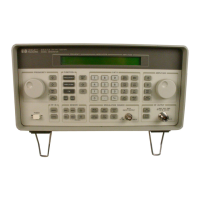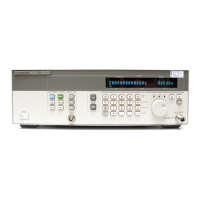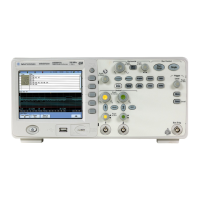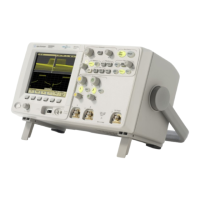71
S:\Hp8960\E1962B CDMA 2000\Pi Release\Reference Guide\Chapters\cdma2000_meas_tx_spurious_desc.fm
Tx Spurious Emissions Measurement Description
Tx Spurious Emissions Measurement Description
How is a Tx Spurious Emissions measurement made?
For cellular frequency bands, and NMT 450, the Tx spurious emissions measurement analyzes the signal
energy at the following frequency offsets relative to the channel’s center frequency:
• ±885 kHz (lower and upper adjacent channels)
• ±1.98 MHz (lower and upper alternate channels)
For PCS frequency bands the Tx spurious emissions measurement analyzes the signal energy at the following
frequency offsets relative to the channel’s center frequency:
• ±1.25 MHz (lower and upper adjacent channels)
• ±1.98 MHz (lower and upper alternate channels)
The relative signal energy (dBc) is measured within a 30 kHz bandwidth.
A graphical view or a numeric view can be displayed.
Tx Spurious Emissions measurements are triggered by a 20 ms clock derived from signaling protocol.
Tx Spurious Emissions measurement characteristics
Tx Spurious Emissions measurements are usually made with the mobile station transmitting at its full power
(traffic channel and fundamental channel control is available in the measurement setup menu).
Limit lines are shown on the graphical display. These lines are set based on the current Cell Band selection. If
the signal energy exceeds a limit line the word Fail appears on the display.
The x-axis on the graphical display is fixed to -2.5 MHz to 2.5 MHz
The y-axis on the graphical display is fixed to 0 dBc/30 kHz to -70 dBc/30 kHz.
A marker is provided to display measurement levels at each offset frequency.
An overall pass/fail indicator is available via GPIB commands (see “FETCh:CTXSpurious[:ALL]?” )
Input Signal Requirements
The Tx Spurious Emissions measurement meets or exceeds specifications when the following requirements
are met:
• The frequency of the signal being measured must be in the range of 411 MHz to 484 MHz, 804 MHz to 934
MHz, 1.75 GHz to 1.78 GHz, or 1.85 GHz to 1.98 GHz, and be within 100 kHz of the expected frequency.
• The signal level into the test set’s RF IN/OUT connector must be in the range of 0 dBm to +30 dBm, and
within 9 dBm of the expected input power (see “RFANalyzer:AUTO:POWer[:SELected]?” ) to meet
specifications.

